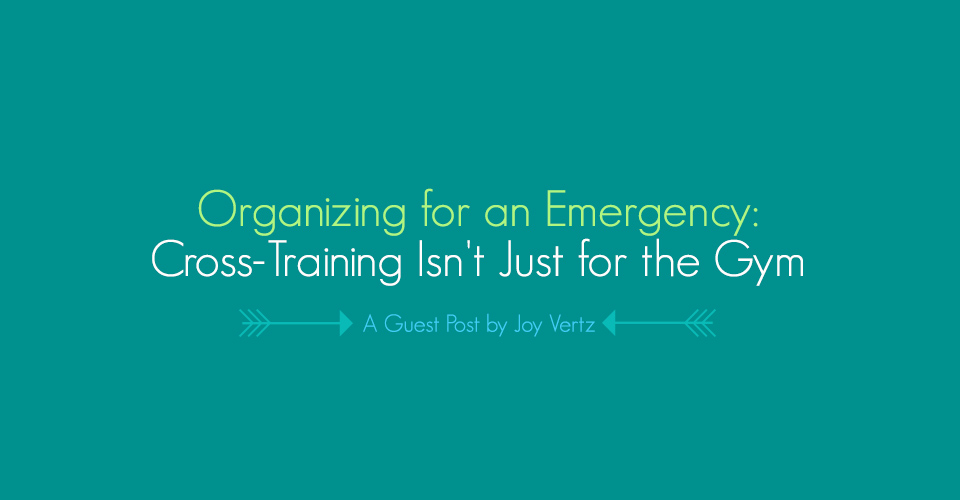Organizing for an Emergency: Cross-Training Isn’t Just for the Gym!
A guest post by Joy Vertz
Note: For these few weeks, I’m talking about ways photographers can prepare for a “bus”: something that will take them out of commission for a while and possibly leave their business in the hands of backup help. I’m answering the following question: “What are some easy things I can do to make sure my business runs smoothly when I’m away?”
At this point we’ve gone over a lot of the ideas behind emergency planning. We’ve talked about organizing your session files for success. We’ve gone over some ways to get things written down. So much theory. So much thought. So much desk duty.
It’s time for ACTION, right?
Today we’re talking about an active approach to emergency planning that could be used before or after everything that’s been discussed so far. Instead of getting started on paper, you could start with an activity that would help clearly define:
- What a replacement does not know (that they need to) about mission-critical jobs
- What processes could be set up to make sure that knowledge gets shared
- How those processes will actually work – not on paper…in real life
It’s a two-step approach: a fire drill, then cross-training.
Just to clear up any misconceptions here, the fire drill is NOT the kind you did in elementary school, and not the kind where you switch seats in your car at a stoplight. Likewise, the cross-training will cost you nothing extra in gym memberships and you don’t need to own any Spandex.
Fire Drill
The kind of fire drill I’m talking about here is a practice run where you ask someone to take on a different role for a while and try to do another person’s job. Whether your spouse is subbing for you or another backup person is subbing for one of your employees, the same ideas apply.
Here are the basics:
- Pick a day where you don’t have too much else going on – fewer interruptions. For the job that’s being fire drilled, pick the most likely person to be the alternate. They are going to practice stepping into that role for this activity.
- The alternate is given the job of picking up where the employee (or you) left off. Make sure to give the alternate the freedom to ask or write down ANY questions they have as they’re trying to figure things out (“Where does this go? Where do I find that? Why do I use the files in this stack and not that one?”). The whole point of this exercise is to ask the questions that people would be asking in an emergency…except BEFORE you have to deal with an emergency.
So what you want to end up with is a list of questions the replacement was asking – what they needed to know in order to do the job. Once you have that, it’s time to start cross-training…showing people how to step into each other’s shoes.
Cross-Training
If the alternate in the fire drill was asking questions and then getting answers as they were trying to find their way around that unfamiliar job, the cross-training has already started!
Cross-training is just knowledge-sharing, and it can be as informal as that. Of course it can be more organized and planned, but that depends on your business and what it needs. Here are some things to remember about cross-training as you plan your strategy:
- It’s an ongoing process. When cross-training is done a little bit at a time on a continuing basis, it’s not only less disruptive to your studio’s workflow, it’s going to be remembered and used more often. Taking time to shut down and do formal “training” (then doing nothing after that) is a sure way to let everyone forget over time.
- There’s something in it for the employees also. It might seem like a burden to follow around someone else while you could be doing your own work. However, picking up new skills makes employees more valuable to the team. Additionally, added skills make an employee a better candidate if they want a promotion.
- Cross-training should happen early and regularly, especially for new hires. It’s important for everyone to understand, as soon as possible, that they’ll be expected to pick up new skills and they will be a part of making the whole system more stable and effective. This will help both the employees and the business to grow over time.
For you one-person shops out there, you know that there’s no such thing as, “not my job.” Everything’s on you, so you might think this doesn’t apply to your situation. Think again.
First, you’ll need to check in every now and then to make sure your backup has the tools and information they need to do their job. Also, if your plan is to grow your business, keep these ideas in mind as you hire new people and give them increasing amounts of responsibility. Set the right tone from the beginning!
Having recently come through a “bus” incident myself, I can say that everything my staff and I did beforehand to make the studios run more smoothly really paid off. I was able to take time to recover and step back into the office with confidence! My staff really knew what they were doing – all their effort is making my studios a fantastic place to work.
Now that this series is wrapping up, let me just encourage you by saying this: the best time to deal with an emergency is when there is not yet an emergency. Not only that, all the emergency planning you do will help your business become more stable, efficient, and successful in so many other ways!
Connect with Joy here and on Instagram / Twitter @joyvertz.
Tags: Featured, Marketing, Speaker Team









